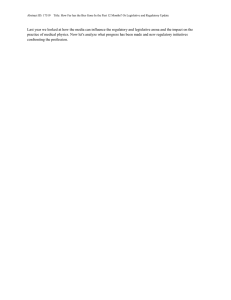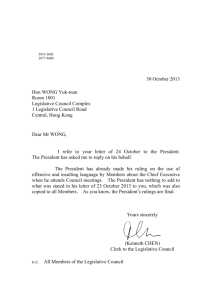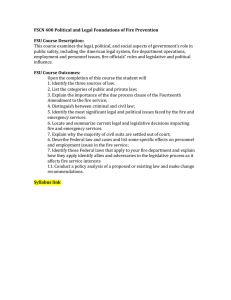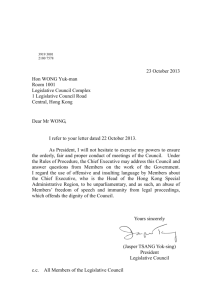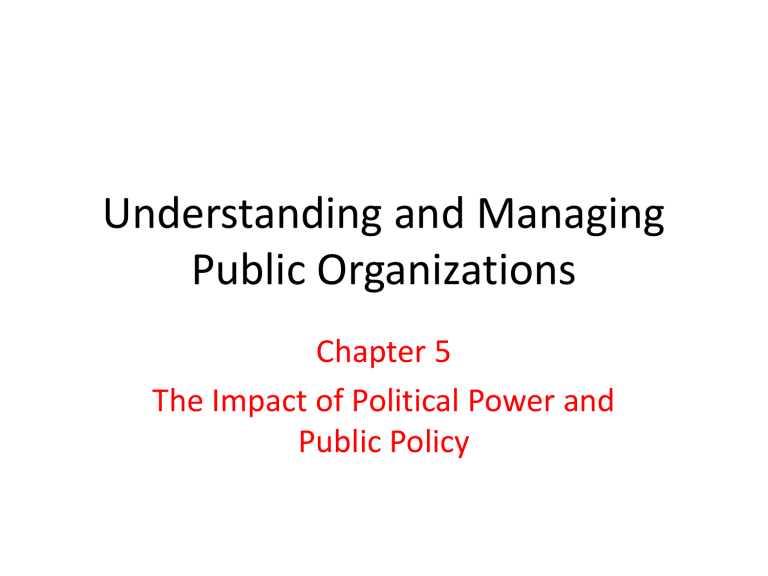
Understanding and Managing Public Organizations Chapter 5 The Impact of Political Power and Public Policy Two Views • Discussion falls into two camps: • Bureaus and bureaucrats are seen as independent and influential. • Bureaus and bureaucrats are impotent. • Both views have some merit. Bureaucratic power is a dynamic mixture of both conditions. • Numerous cases showing agencies’ responsiveness to president, courts, Congress • Also evidence of “bottom-up” processes with agencies independently initiating policy • Proactive behavior of public mangers is a common theme in leadership literature. Sources of Political Authority and Influence • Chief executives • Legislative bodies • Courts • Government agencies • Other levels of government • Interest groups • Policy subsystems ands policy communities • News media • Public opinion • Individual citizens Sources of Political Authority and Influence of Institutions, Entities, and Actors in the Political System Chief Executives •Appointment of agency heads and other officials •Executive staff and staff offices (for example, budget office) •Initiating legislation and policy directions •Vetoing legislation •Executive orders and directives Legislative Bodies •Power of the purse: final approval of the budget •Authorizing legislation for agency formation and operations •Approval of executive appointments of officials •Oversight activities: hearings, investigations •Authority of legislative committees •Initiating legislation Courts •Review of agency decisions •Authority to render decisions that strongly influence agency operations •Direct orders to agencies Government Agencies •Oversight and management authority (GAO, OMB, OPM, GSA) •Competitors •Allies •Agencies or government units with joint programs Sources of Political Authority and Influence of Institutions, Entities, and Actors in the Political System Other Levels of Government • “Higher” and “lower” levels • Intergovernmental agreements and districts Interest Groups • Client groups • Constituency groups • Professional associations Policy Subsystems and Policy Communities • Issue networks • Inter-organizational policy networks News Media • Constitutional protections of freedom of the press • Open meetings laws, Sunshine laws General Public Opinion • Providing (or refusing to provide) popular support Individual Citizens • Requests for services, complaints, other contacts Public Organizations and the Public • Public managers are influenced by public opinion, including the public’s. • General attitude about government • Attitudes toward specific policies Public Opinion and Mass Publics • Public organizations need support from – Mass publics: broad diffuse populations – Attentive publics: more organized groups that are interested in specific agencies • The public manager’s concern is to maintain enough authority and discretion to meet organizational goals. • Bureaucratic power is essential to the fundamental organizational process of gaining financial resources, grants, and other resources from the environment. Ambivalences and Paradoxes in Public Opinion • The public expresses negative attitudes and ambivalence toward government but at the same time can have high praise for specific agencies and programs. Public Opinion, Agencies, Policies and Officials • The general level of public support for a particular agency’s programs affects the agency’s ability to maintain a base of political support. • Certain agencies hold a more central place than others in the country’s values. Public Opinion • General level of support affects agency’s ability to maintain base of political support. – Praise for NY fire fighters after 9/11 – Periods of antigovernment sentiment often prompt reforms. New institutions and structures can upset the organization and present numerous challenges. – Changes might include • New lines of authority • New reporting requirements Public Opinion • It’s often difficult to gauge what the public really wants. • Public regards some agencies as more important than others (e.g. police, defense). • Public sentiment can help or hinder public management. • Hargrove and Glidewell (1990) propose an agency classification in relation to public opinion. • How does the public perceive the agency’s clientele? • Is agency respected? • How important is the agency? Media Power: Obvious and Mysterious • Social media platforms such as Facebook and Twitter have changed the political landscape. • Politicians, agencies, and citizens now rely on social media for messaging. • Social media also has a downside – Information distortion – Biases Media Power: Obvious and Mysterious • Close media scrutiny of government plays an indispensable role in governance, but news coverage can tend to focus more on the negative than the positive, distorting citizens’ views of government • Recent surveys show that opinions about news coverage are based in part on partisanship. News Media • Media attention varies by administration and agency. • Media attention can shift unpredictably. • Media tends to take an adversarial stance. • Bad press can damage budgets, programs, and careers. • Agencies value good coverage and spend a least five hours per week on matters pertaining to media (Graber, 2003). • Media serves as a watchdog, reporting government waste and abuses. Guidelines for Managing Relations with the News Media Experts on managing relations between government agencies and the news media propose the following: • Understand the perspective of the media: their skepticism, their need for information and interesting stories, their time pressures. •Organize media relations carefully: spend time and resources on them and link them with agency operations. •Get out readable press releases providing good news about the agency; be patient if the media respond slowly. Source: Adapted from Cohen and Eimicke (1995), Chase and Reveal (1983), and Garnett (1992). Guidelines for Managing Relations with the News Media The Community Relations Office of the City of Claremont, California, published the following guidelines for managing relations with reporters: • Prepare an agenda on each subject the media may be interested in. Include a list of three to five points you want to sell to the reporter. • Write or verbally deliver quotable quotes of ten words or less. • Listen carefully to the question. The reporter may have made incorrect assumptions, and you will need to give clearer background information before answering the question. • Avoid an argument with the reporter. Source: Adapted from Larkin (1992). Guidelines for Managing Relations with the News Media •Respond to bad news and embarrassing incidents rapidly, with clear statements of the agency’s side of the story. •Seek corrections of inaccurate reporting. •Use the media to help boost the agency’s image, implement programs, and communicate with employees. •To carry all this off effectively, make sure that the agency performs well and be honest. Source: Adapted from Cohen and Eimicke (1995), Chase and Reveal (1983), and Garnett (1992). Guidelines for Managing Relations with the News Media • If interrupted in mid-thought, proceed with your original answer before answering the next question. • Challenge any effort to put words into your mouth. • Don’t just answer the question; use the question as a springboard to sell your agenda. • If you do not know the answer, say so. Do not speculate. • If you cannot divulge information, state why in a matter-of-fact way. • Be positive, not defensive. • Always tell the truth. Interest Groups, Clients, and Constituencies • Support of organized groups is essential to the well-being of agency. • Role of interest groups is controversial. • Some criticisms: – There is a danger that special interest politics will further fragment the system, complicating communication and coordination. – System favors some powerful private interests over public interest. – Agency can become “captive.” – Revolving door Interest Groups, Clients, and Constituencies • Support from constituent groups can • Bolster and legitimize agency work • Defend agency against budget cuts • Provide agency with important information, expert reports • Provide competition between interests to give rise to various viewpoints • Legislative Bodies: Formal Authority Formal legal authority over agency comes in many forms. A few examples: – – – – • Power of the purse Legislation Oversight Committees Legislative bodies have substantial authority over agencies. – – – – Enabling statutes detail agency authority but can be amended. Statutory authority can be vague or specific. Budgets Oversight, including hearings, reports, investigations • Formal authority always operates in a political context. • Formal authority can weaken or bolster agency. Legislative Bodies: Informal Influence • Legislative influences can be relatively informal as well, rather than codified into law. • Legislators call administrators to press for information or actions. • Exerting influence to hire political friends • Exerting influence to fire political foes Limits on Legislative Power • Agencies are typically the experts. • Implementation is a source of power. • Close scrutiny over agency often has minimal political payoff. – Could jeopardize relationships – Eliminate potential sources of favors for constituents Chief Executives • Rivals legislative branch for strongest influence • Chief executives presumably have the greatest formal power over bureaucracies in their jurisdictions. • Influence powers are complex and dynamic. • Methods of influence: – Appointments of agency heads – Budgeting authority – Executive branch proposes initial budget, although legislature approval is necessary. – Policy initiatives and executive orders Courts • Some experts claim courts exert powerful controls over bureaucracy, and others see them as ineffectual. • Courts confine agency to statutory authority but under the right circumstances can wield immense authority. • Courts require agency to follow due process in rulemaking. Other Government Agencies as Overseers, Allies and Competitors • Relationship of bureaucracy to other bureaucracies and different levels of government can be complex. • Interdependencies require cooperation. • Grants sometimes require coordination between agencies. • Federal system fragments authority. • Agencies sometimes compete for resources and control over programs. Public Managers’ Perceptions of the Political Environment • Some studies indicate that state agency managers see their legislatures as the most influential, with the governor coming second. • Local managers see the chief executive—the mayor—as the most influential actor. • State and local agency managers rate interest groups as much less influential than legislatures and chief executives but often see them as valuable contributors to decisionmaking. Public Managers’ Perceptions of the Political Environment • Three conceptions of politics that emerge in state agency executives’ descriptions of their political activities (Olshfski,1990): –Political astuteness –Political activities –Electoral politics The Public Policy Process • Many arenas, actors, levels. and instruments • Policy subsystems Some Labels for Policy Actors • Iron Triangle – Old name to describe relationship among bureaucracy, congressional committees, and interest groups. – Relatively stable – Entry into the triangle is rare. • Issue Network – Businesses, organizations, bureaucracies, individuals, legislative committees, and subcommittees all have interests in policy. All attempt to influence the development and execution of public policy. • Barriers to entering the network are rather low. • Those actively involved in the network at any one time will fluctuate, and levels of activity will fluctuate. Iron Triangle Congress Low regulation Can lobby for agency support The Agenda-Setting Process and Garbage Can • The garbage can model depicts decisionmaking in organizations as being much less systematic and rational than is commonly supposed. – People are not sure about their preferences or about how their organization works – Solutions can chase problems. – Choice opportunities are like garbage cans in which problems, solutions, and participants come together in a jumbled fashion. Kingdon’s Streams Metaphor Problem Stream Window of Opportunity Policy Stream Political Stream Time Kingdon’s Streams Metaphor • An adaptation of the garbage can model • The streams: – The state of politics and public opinion (politics stream) – The potential solutions to a problem (policy stream) – Attributes of problems and the attention to them (problem stream) Kingdon’s Streams Metaphor • Streams are parallel and somewhat independent of each other. • Policy entrepreneurs try to join the streams in a window of opportunity. • Window of opportunity: the possibility of policy change Kingdon’s Agendas, Alternatives, and Public Policies: Basic Theory • Three separate and independent streams come together in evolutionary manner. • Windows of opportunity • Highly fluid interactions of streams: – Coupling of problems and policies – The role of entrepreneurs Networks and Collaboration in Public Management and the Policy Process • Networks are “structures of interdependence involving multiple organizations or parts thereof, where one unit is not merely the formal subordinate of the others in some larger hierarchical arrangement” (O’Toole). – Atypical chains of command and hierarchical authority – The lines of accountability and authority are loosened. – Management requires more reliance on trust and collaboration. The Nature of Networks • A real measure of effectiveness should not be focused on any individual organization. • A network will most likely be effective when a core agency integrates the network, when the government’s mechanisms for fiscal control are direct and not fragmented, when resources are plentiful, and when the network is stable (from Milward and Provan study). The Nature of Networks • Network effectiveness is defined as the attainment of positive network-level outcomes that individual organizational participants cannot achieve by acting independently (Provan and Kenis, 2008) . • Leadership Networking and Organizational Effectiveness – Research shows positive relations between networking behaviors and proactive management, organizational performance, management tenure, time in a given network, and gains for a given organization. Negative Networks • Networks formed to tackle “wicked problems.” • Some factors lead the networked actors to become dependent on each other to solve policy problems through joint action. – Cognitive uncertainty – Strategic uncertainty – Institutional uncertainty Collaboration in Public Management • Multiple Definitions • Page’s (2003) five principles: 1. 2. 3. 4. 5. Agreeing to work together Planning Assessing progress Improving performance Allocating and mobilizing resources Collaboration in Public Management • Multiple Definitions – Thomson, Perry, and Miller (2009): a process in which autonomous or semi-autonomous actors interact through formal and informal negotiation, jointly creating rules and structures governing their relationships and ways to act or decide on issues that brought them together; it is a process involving shared norms and mutually beneficial interactions
